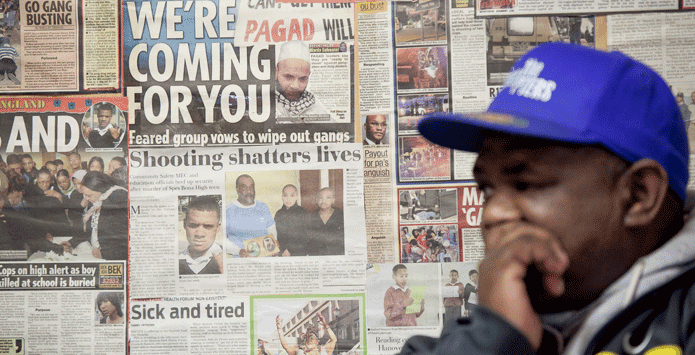It’s Friday night in Hanover Park. The streets hum with the frequency of youth uncontained. Teenage boys collect towards the shadowy corners, while adolescent girls pass by arm-in-arm and children careen between the rubbish bins and clothes lines rimming the “courts”, three-storey brick flats that apartheid built. “Stop here,” Colin Barends (45) says. The electric whir of the window lowers to the cool curiosity of three boys, none older than 18, all speaking an unperturbed melodic Afrikaans as they exchange remarks with Colin. “Those three are high-risk individuals,” says Colin as we drive away. “The one’s daddy is a high flyer, the smaller one’s daddy I know from jail.” Satisfied that the boys are “quiet” for the night, he continues to direct me through the area’s maze of small lanes and cul-de-sacs, carving a mysterious path according to a map that exists only in his mind.
Colin is not your typical gangster. In fact he is no longer a gangster, though it remains unclear to me exactly how “ex” someone with Colin’s history ever truly becomes. The first time I met Colin, the man who pulled up on a white scooter in front of a squat brick house in Bridgetown, Athlone upended my image of a high-ranking prison gang member. Moon-faced and almost bashful in demeanour, the stocky figure in a black and yellow tracksuit could have been any middle-aged guy at Vangate Mall. A scar resembling the Southern Cross arcs over his right eye, its horizontal axis deep enough to make you wonder. It’s the only visible trace of Colin’s past.
But Colin’s past is never far behind. Especially when patrolling Hanover Park. One of Cape Town’s 1970s-era dumping grounds for non-whites exiled from District Six and other desirable city areas designated whites-only enclaves, the neighbourhood’s very name is shorthand for the violence, drugs and gang warfare that riddle much of the sprawling Cape Flats today. As the night wears on, the seemingly random nature of our route emerges for what it is: a systematic analysis that incorporates every house and street that Colin knows—either from recent intel or general experience—to be a site of potential violence. En route, he checks in with anyone who might be armed, has a score to settle or could know something about something that’s going to happen. This intelligence gathering usually occurs somewhere between asking after a child, brother, girlfriend or “mommy” (as mothers are universally referred to in this community), and punting a new job database or rehab programme. It is this unlikely combination of Colin’s constant and embedded presence, storied past, personal well of empathy and highly analytical mind that underlie his success as a “violence interrupter”.


